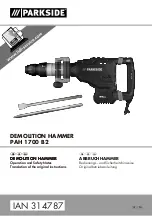
4-12
Applied Operation
PAD-L
4.3
Output ON/OFF control
4.3.1
Output ON/OFF control (I)
This method is used to control ON/OFF for the output using external contact. When
the external contact is closed, the output drops to nearly 0 V.
○
○
○
○
○
○
○
○
○
○
○
○
○
○
○
○
○
○
○
○
○
○
○
○
○
○
○
○
○
○
○
○
○
○
○
○
○
○
○
○
○
○
○
○
○
○
○
NOTE
•
In this method, the voltage set value is displayed when the CURRENT/VOLT.
LIMIT switch is pressed while output is OFF, but not the current set value.
○
○
○
○
○
○
○
○
○
○
○
○
○
○
○
○
○
○
○
○
○
○
○
○
○
○
○
○
○
○
○
○
○
○
○
○
○
○
○
○
○
○
○
○
○
○
○
CAUTION
•
A negative voltage of approx. 0.6 V is generated when the output
is turned off, and a reverse current of approx. 10 mA may flow.
If this negative voltage presents problems, use "Output ON/OFF
control (II)" described in 4.3.2.
•
Do not use "Output ON/OFF control (I)" with "Output current
control with an external voltage", as described in 4.4.2. Failure to
do so may result in short-circuiting of the output of an external
voltage source when output is OFF.
Connecting procedure
1.
Turn off the POWER switch.
2.
Connect a contact S (switch) across the control terminal 1 and 2 as
shown in Fig. 4-9.
WARNING
•
Isolate the external contact (S) and the cable connected to it with
at least the isolation voltage of the unit. For details, see 2.6
"Grounding the output terminal."
•
When using a shielded cable for the connection, protect the
uncovered part of the cable with an insulation tube of at least the
isolation voltage of the unit.
CAUTION
•
If the contact S is disconnected, the output will be turned ON. Use
crimp terminals or the like to secure this contact in place.
○
○
○
○
○
○
○
○
○
○
○
○
○
○
○
○
○
○
○
○
○
○
○
○
○
○
○
○
○
○
○
○
○
○
○
○
○
○
○
○
○
○
○
○
○
○
○
NOTE
•
To reduce the effects of noise on output, use a 2-core shielded wire or a
twisted-pair wire to connect to terminals, making them as short as possible.
Longer wiring results in greater susceptibility to the effects of noise, and use of
cables with antinoise measures may not solve the problem, resulting in
improper operation.
When using a shielded wire, connect the shield to the + (pos.) output terminal.
Summary of Contents for PAD-L III Series
Page 4: ...II PAD L...
Page 16: ...P 6 Preface PAD L...
Page 40: ...2 12 Precautions and Preparations for Use PAD L...
Page 86: ...4 34 Applied Operation PAD L...
Page 98: ...5 12 Names and Functions of Controls PAD L...
Page 130: ...7 14 Specifications PAD L...
















































